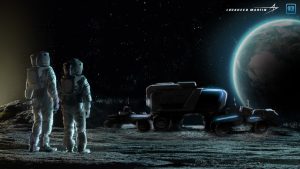General Motors [GM] and Lockheed Martin [LMT] are teaming up to develop a lunar terrain vehicle for NASA’s Artemis program that would be used to transport astronauts on the moon, the companies announced Wednesday.
A Request for Proposals for the Lunar Terrain Vehicle (LTV) is expected to be released later this year, according to Jeff Ryder, GM Defense’s vice president of growth and strategy, with the companies planning to offer an all-electric platform with autonomous capabilities.

“When I think about the Artemis program, we’re going to take humans back to the Moon, something we haven’t done in almost 50 years. That’s so exciting, in general. In order to have a sustained presence at the Moon, we’re going to need mobility. It’s going to be a critical piece of that infrastructure. It’s also going to take aerospace companies and non-aerospace companies working together to build that infrastructure. And for mobility, I could think of no better partner than the number one U.S auto manufacturer in GM,” Lisa Callahan, Lockheed Martin’s vice president of commercial civil space, said during a virtual press conference.
Callahan, who noted Lockheed Martin developed the Orion spacecraft for the Artemis program, said the LTV offering will make use of the company’s deep space robotic and human spacecraft capabilities.
NASA is aiming to land humans back on the moon by 2024, to include using Boeing’s [BA] Space Launch System, SpaceX’s Starship HLS lunar lander and the Orion spacecraft.
“The alliance makes sense now because of the incredible opportunity we have to combine the robust expertise of both of our companies to accomplish the mobility goals of the Artemis mission” said Alan Wexler, GM’s senior vice president for innovation and growth, who noted the company built the original Lunar Roving Vehicle used in the final three Apollo missions. “This is one of several initiatives that we are working on together, so stay tuned to hear more about the others. It goes beyond this program.”
The officials said more specifics on the LTV offering will be detailed as requirements come together under the RFP, while noting that any platform will be required to traverse rugged terrain, operate in temperatures from -280°F to 260°F, have the ability to drive autonomously and provide extended range across the surface of the Moon.
Wexler said LTV is an opportunity to build off GM Defense’s recent success using largely commercial parts to rapidly deliver the Army’s new Infantry Squad Vehicle (ISV).
“We leveraged all of our commercial capabilities and experience [for ISV], and we look to do the same here as it relates to autonomy and electrification,” Wexler said.
The Army’s lead official for ISV said the program represented a “paradigm shift” for how the service can get after more agile acquisition practices by bringing in more commercial parts to the Army supply system (Defense Daily, May 7).
Ryder said LTV development will make use of GM’s push to invest over $27 billion through 2025 in its electric and autonomous vehicle portfolio.
“Part of this is leveraging the commercial technology baseline that we have. Where we can, we want to bring proven performance, proven technology. But there’s certainly going to be a significant development effort associated with this just given the nature of the program and its objectives,” Ryder said. “Whether it’s traversing the lunar surface or conducting science missions, logistics operations in support of the habitat and the permanent facilities, we see lots of different applications for mobility.”